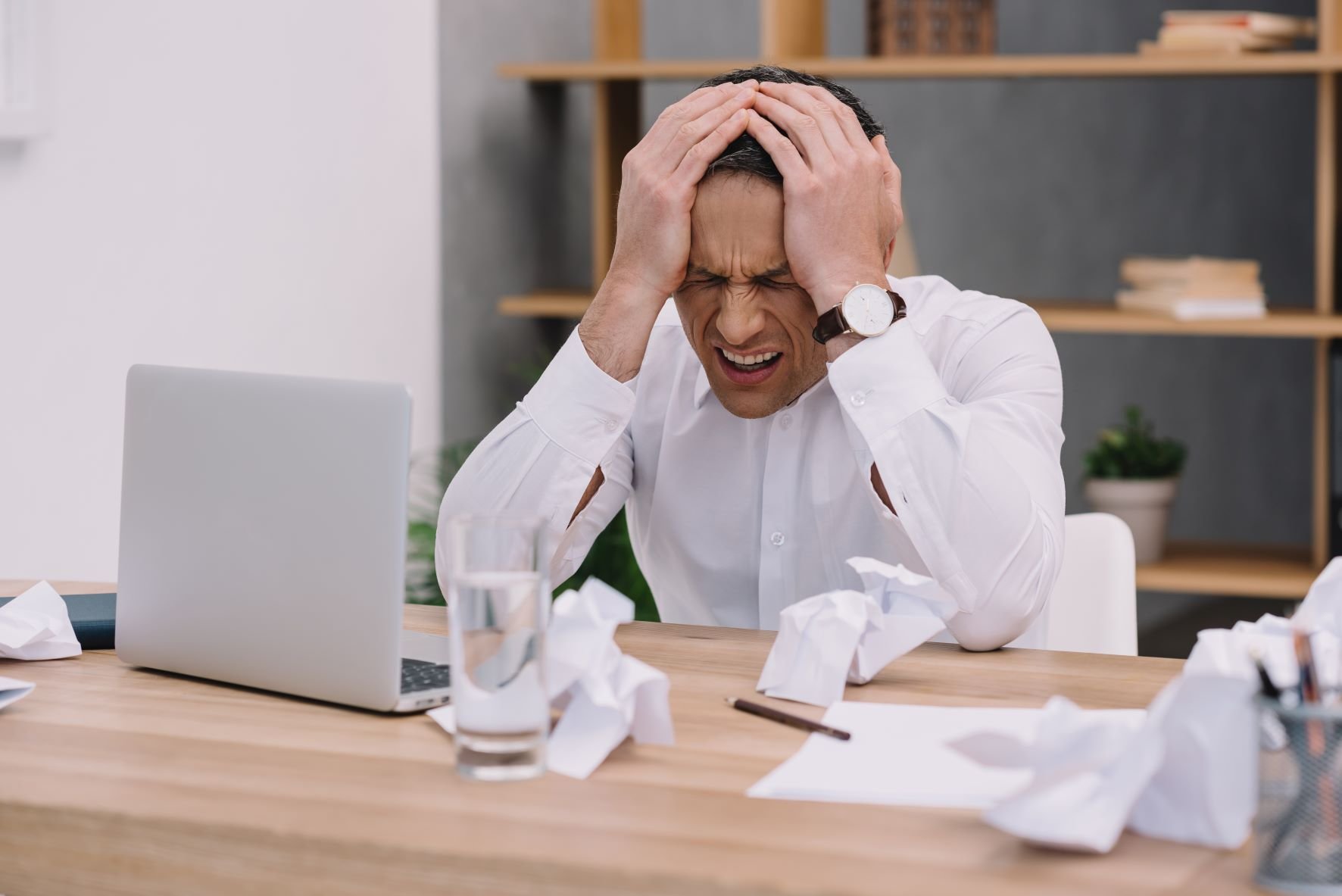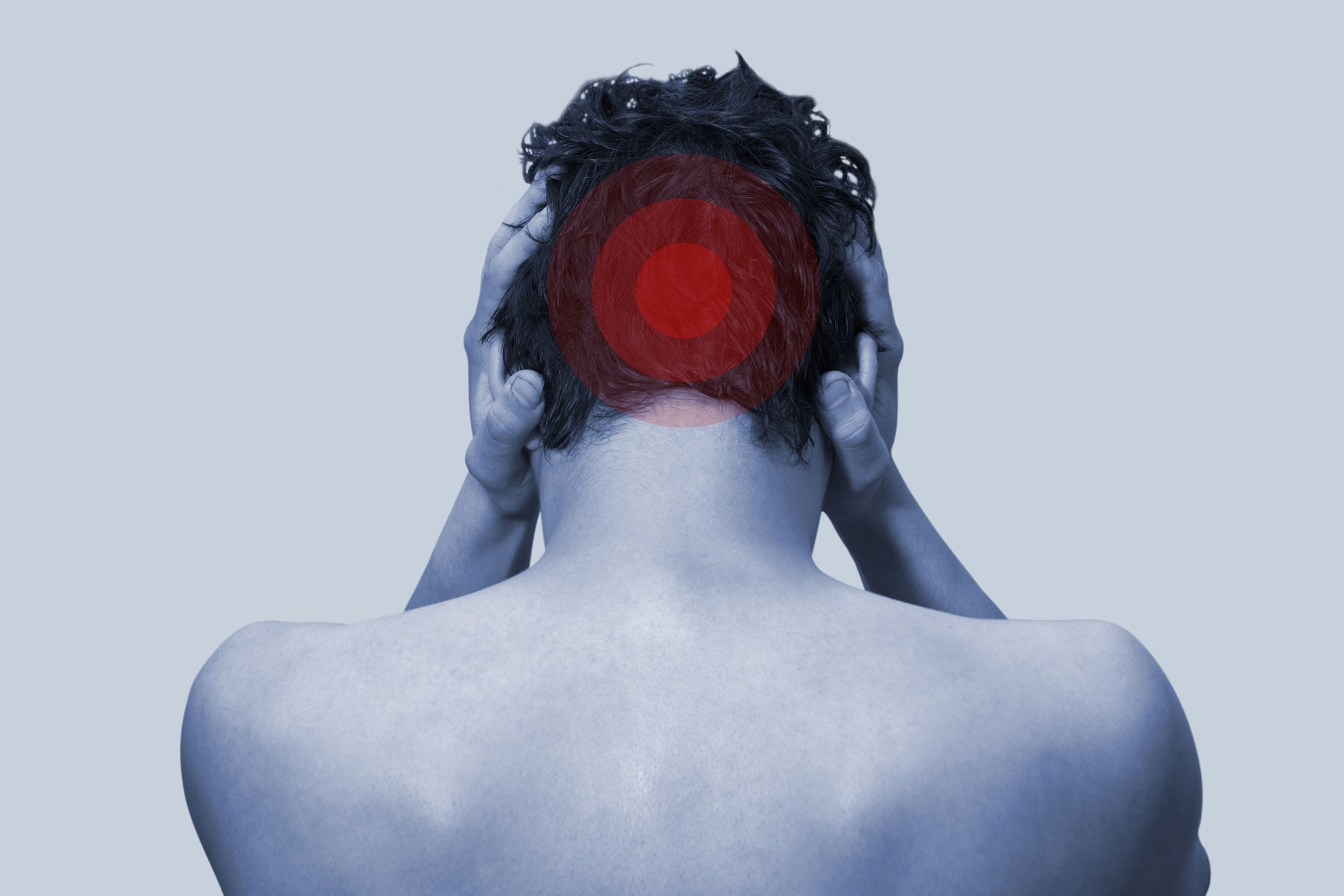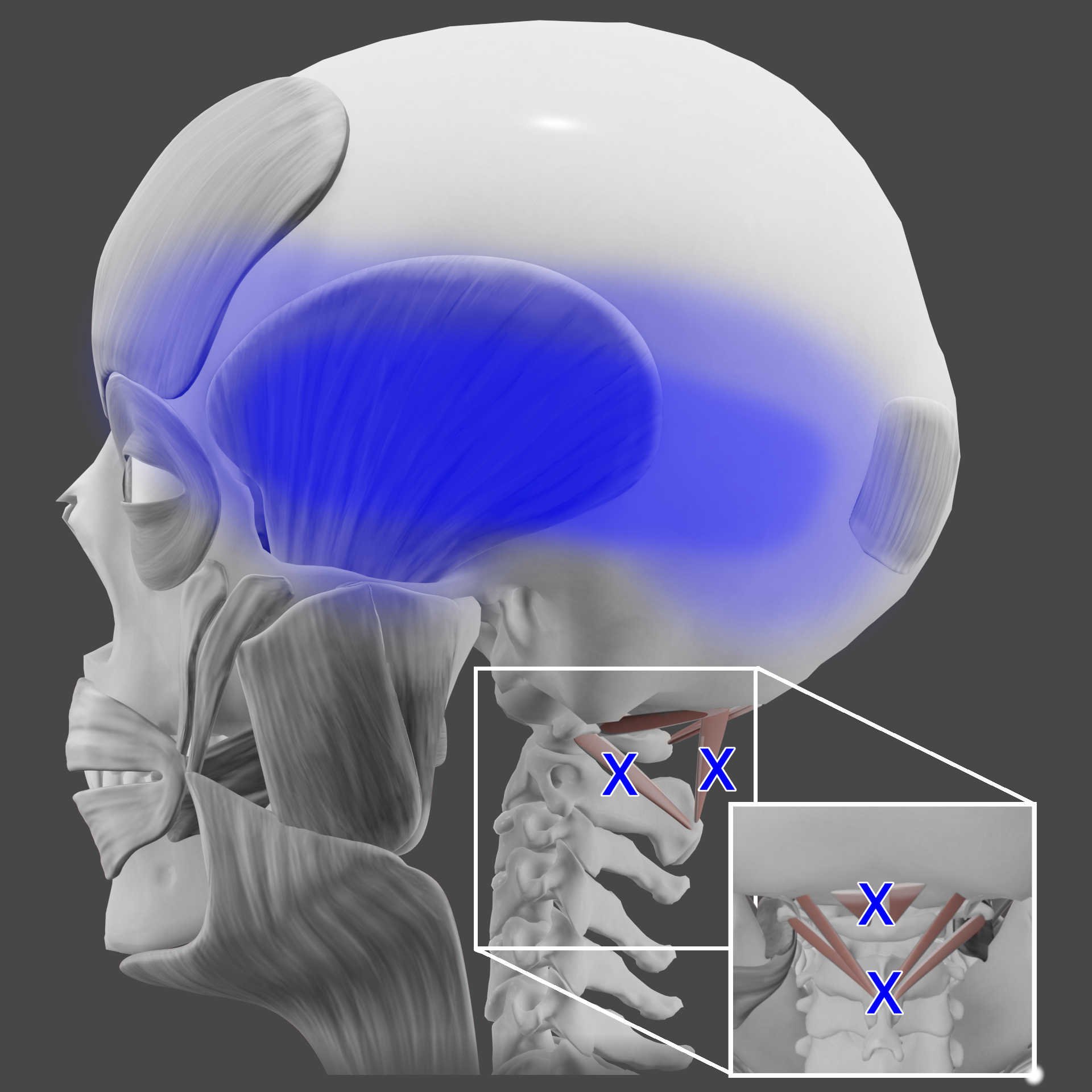Acupuncture for Splenius Capitis Pain
A person with a headache and top of head pain (vertex pain)
About the splenius capitis muscle
The splenius capitis muscle is a muscle located in the back of the neck. It is one of the two muscles that make up the splenius muscle group, the other being the splenius cervicis muscle. The splenius capitis works to extend and rotate the head and neck (cervical spine). It is located superficial to the paraspinal muscles, and deep to the trapezius muscle. It is posterior and medial to the levator scapulae muscle.
The splenius capitis is an important muscle for maintaining good posture, as it helps to keep the head and neck in a neutral position. When the muscle becomes tight, fatigued or overworked it can lead to trigger points that can refer pain to the top of head head or cause headaches.
Splenius capitis trigger point research shows that this muscle is commonly involved in chronic tension type headaches along with the suboccipital, temporalis, upper trapezius, and splenius cervicis muscles.
Trigger points in the splenius capitis muscle may also be associated with cervical radiculopathy (nerve pain).
Another study found that people that have chronic tension type headaches have more active or latent trigger points that people without headaches.
Splenius capitis pain may also be associated with tinnitus (ear ringing) along with trigger points in other muscles like the masseter, sternocleidomastoid, and upper trapezius.
Read more to learn about splenius capitis trigger points and how acupuncture and dry needling can help relieve neck pain and headaches naturally.
Splenius capitis origin and insertion
Splenius capitis origin:
The splenius capitis origin is at the inferior one half of the ligamentum nuchae and spinous processes of C-7 to T-4.
Splenius capitis insertion:
The splenius capitis insertion is at the mastoid process and the lateral portion of the superior nuchal line
Since the splenius capitis muscle attaches on the mastoid process (lateral part of the back of the head) and the lower cervical and upper thoracic spine, we can see that is brings the head and spine closer together. This results in same sided rotation, lateral flexion, and extension of the head and neck.
Splenius capitis action
Unilaterally:
Rotate head and neck to same side
Laterally flex head and neck
Bilaterally:
Extend head and neck
The splenius capitis works together with the splenius cervicis to extend and rotate the head and neck. According to a study, when the head is turned to one side with the chin pointed upwards, the splenius capitis muscle on the same side works to rotate the head and neck, while the opposite side splenius capitis muscle works to extend the head and neck.
Synergists and antagonists of the splenius capitis
Splenius capitis synergists:
Splenius cervicis: also located in the back of the neck, it also extends and rotates the head and neck.
Semispinalis capitis: located in the upper back, and extends and rotates the head and neck.
Trapezius muscle: located in the upper back and shoulders, and stabilizes the head and neck during movement.
Levator scapulae: located in the upper back and shoulders, and elevates and rotates the scapula, which assists in head and neck rotation.
Erector spinae muscles: This group of muscles runs along the spine, and helps to extend and rotate the head and neck.
Splenius capitis antagonists:
Sternocleidomastoid (SCM): located in the front of the neck, it flexes and rotates the head and neck in the opposite direction of the splenius capitis.
Scalenes: These muscles are located in the front of the neck, and they flex and rotate the head and neck.
Trapezius (upper fibers): located in the upper back and shoulders, it stabilizes the head and neck during movement.
Deep cervical flexors: This group of muscles, located in the front of the neck, help to maintain the posture and balance of the head and neck.
Antagonists of the splenius capitis mainly work to flex the neck and rotate the neck (to the opposite side of the splenius capitis).
There may be additional synergists or antagonists as muscle function is complex and involves groups of muscles working together. Dysfunction or muscle imbalance in synergist or antagonist muscles can affect the splenius capitis muscle and lead to trigger points in it. A good treatment will address the area of pain as well as supporting areas that contribute to the pain and dysfunction.
Splenius Capitis Trigger Points
Main complaints related to splenius capitis trigger points include:
Vertex pain
Headaches or migraines
The splenius capitis muscle is known for causing vertex pain or top of the head pain when it has trigger points. It is a muscle commonly involved in headaches and neck pain.
Associated trigger points include the splenius cervicis, levator scapulae, and erector spinae muscles which which can completely restrict or block rotation of the head and neck to that side.
Splenius Capitis Trigger Point Locations
Splenius capitis trigger points can be located along the belly of the muscle. The most common one tends to appear approximately in line with the C-3 vertebrae. Splenius capitis muscle pain refers to the top of the head (vertex pain) and has a fairly distinct referral pattern.
Splenius capitis trigger point location and pain referral pattern
Signs and symptoms of splenius capitis trigger points
Vertex or top or the head pain
Tension headaches (top of head)
What causes splenius capitis pain and trigger points?
Car accident
Postural stress
Working at a desk with head turned to one side
Falling asleep in bad neck position
Cold air conditioner blowing on the neck together with muscle fatigue
The main causes of splenius capitis trigger points are stresses of postural, impact, excess activity, or environmental nature. This can include excessive head turning or neck extension while working on multiple computer monitors, sitting too close in a movie theatre, or sitting in a poor position. Falling asleep with in a crooked position like on an armrest or without a pillow can also cause splenius capitis trigger points.
Environmental factors like an air conditioner blowing directly on the neck can also make it easier for trigger points in the posterior neck to form. Impact stress includes car accidents, and trauma from impact sports like football, soccer, and hockey. Activity stress can include lifting heavy weights or turning the neck while pulling something heavy.
One study found that whiplash injuries often included splenius capitis trigger points - it was the second most frequently involved muscle, especially in front impact accidents where 94% of subject had these trigger points.
Trigger points in the splenius capitis muscle rarely occur alone. There are often trigger points in the splenius cervicis, levator scapulae, and other posterior neck muscles that can also be present. Treatment of splenius capitis synergists can boost the effects of treatment since it can provide for a full stretch of all the relevant neck muscles.
Splenius capitis treatment for trigger points
Acupuncture and dry needling offer effective myofascial release techniques to deactivate trigger points in the splenius capitis muscle.
Your acupuncturist will identify the trigger points and taut bands of muscle that are possible sources of neck pain, vertex pain, and headaches. Trigger point therapy with an acupuncture needle helps to relax the muscle to restore function, improve range of motion, and reduce pain.
Other modalities like electroacupuncture, cupping, gua sha, and tui na can also help with splenius capitis trigger point symptoms.
Over to you
If you liked this article, please share with friends and family who may be suffering with neck pain or headaches.
Sources:
Travell, J. G., Simons, D. G. (1993). Myofascial pain and dysfunction: The trigger point manual (Vol. 2). London: Lippincott Williams & Wilkins.
Biel, A., & Dorn, R. (2010). Trail guide to the body: A hands-on guide to locating muscles, bones and more. Boulder, CO: Books of Dicovery.
Janda, Vladimír. “Muscle Function Testing.” (1983).
Takebe K, Vitti M, Basmajian JV. The functions of semispinalis capitis and splenius capitis muscles: an electromyographic study. Anat Rec. 1974 Aug;179(4):477-80. doi: 10.1002/ar.1091790407. PMID: 4842939.
Chatchawan U, Thongbuang S, Yamauchi J. Characteristics and distributions of myofascial trigger points in individuals with chronic tension-type headaches. J Phys Ther Sci. 2019 Apr;31(4):306-309. doi: 10.1589/jpts.31.306. Epub 2019 Apr 1. PMID: 31037000; PMCID: PMC6451952.
Sari H, Akarirmak U, Uludag M. Active myofascial trigger points might be more frequent in patients with cervical radiculopathy. Eur J Phys Rehabil Med. 2012 Jun;48(2):237-44. PMID: 22614890.
Marcus DA, Scharff L, Mercer S, Turk DC. Musculoskeletal abnormalities in chronic headache: a controlled comparison of headache diagnostic groups. Headache. 1999 Jan;39(1):21-7. doi: 10.1046/j.1526-4610.1999.3901021.x. PMID: 15613190.
Rocha CA, Sanchez TG. Myofascial trigger points: another way of modulating tinnitus. Prog Brain Res. 2007;166:209-14. doi: 10.1016/S0079-6123(07)66018-X. PMID: 17956784.
Baker, B. A. "The muscle trigger: evidence of overload injury." J Neurol Orthop Med Surg 7.5 (1986): 35-44.
Disclaimer: This web site is intended for educational and informational purposes only. Reading this website does not constitute providing medical advice or any professional services. This information should not be used for diagnosing or treating any health issue or disease. Those seeking medical advice should consult with a licensed physician. Seek the advice of a medical doctor or other qualified health professional for any medical condition. If you think you have a medical emergency, call 911 or go to the emergency room. No acupuncturist-patient relationship is created by reading this website or using the information. Morningside Acupuncture PLLC and its employees and contributors do not make any express or implied representations with respect to the information on this site or its use.




